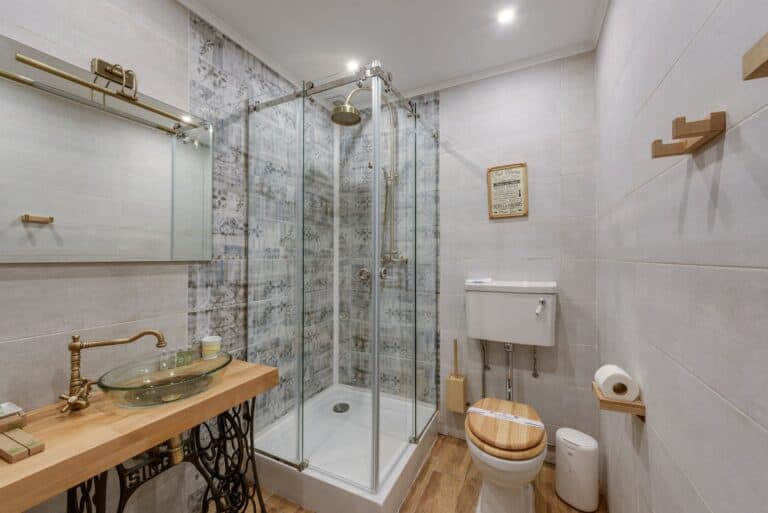Are you tired of looking at peeling paint in your bathroom? Don’t worry, we’ve got you covered! In this article, we will guide you through the step-by-step process of fixing peeling paint in your bathroom. With a little bit of effort and the right tools, you can restore the beauty and safety of your bathroom walls. So roll up your sleeves and get ready to tackle this DIY project – it’s time to say goodbye to those unsightly patches of peeling paint!
Assessing the Damage
You should start by examining the extent of the peeling paint in your bathroom. This will help you determine the causes of paint peeling and identify any areas that need immediate attention. Look for signs of moisture or water damage, as this is a common culprit for paint peeling in bathrooms. It’s also important to check if there are any mistakes in the paint application process, such as not properly cleaning or priming the surface before painting. These mistakes can cause poor adhesion and lead to peeling over time. By carefully assessing the damage, you can better understand what needs to be done to fix the peeling paint and prevent it from happening again in the future. Remember, safety should always be a priority when dealing with issues like this in your home.
Preparing the Surface
Before starting, make sure to thoroughly clean and sand the affected area. This is crucial for ensuring a smooth and long-lasting paint job in your bathroom. Here are some important steps to follow when preparing the surface:
- Begin by cleaning the area with a mild detergent or cleaner to remove any dirt, grease, or soap residue that may be present.
- Rinse the surface thoroughly and allow it to dry completely before proceeding.
- Next, use a fine-grit sandpaper or sanding block to gently roughen up the peeling paint and surrounding areas. This will help promote better adhesion of the new paint.
- Remember to wear safety goggles and a dust mask during this process to protect yourself from any airborne particles.
By properly cleaning and using appropriate sanding techniques, you will create an ideal surface for repainting your bathroom walls, ensuring a professional-looking finish that will last for years to come.
Choosing the Right Paint
To ensure a successful bathroom paint job, it’s important to select the right type and color of paint for your project. When choosing a paint color, opt for lighter shades that can help brighten up the space and make it feel larger. Light colors also tend to hide imperfections better than darker ones. As for the paint finish, consider using a satin or semi-gloss finish as they are more resistant to moisture and can be easily cleaned. These finishes are great for bathrooms where humidity levels are high and splashes are common. Additionally, make sure to choose paints that are labeled as mildew-resistant to prevent any mold or mildew growth in your bathroom. By carefully selecting the appropriate paint color and finish, you can achieve a beautiful and long-lasting result while ensuring safety in your bathroom.
Applying Primer and Paint
Once you’ve selected the right paint color and finish, it’s time to start applying primer and paint. This step is crucial in fixing peeling paint in your bathroom. Before you begin, make sure to wear protective clothing, gloves, and goggles to ensure your safety. The first thing you need to do is prepare the surface by cleaning it thoroughly and removing any loose or peeling paint. Next, apply a coat of high-quality primer designed specifically for bathroom surfaces. This will help the new paint adhere better and prevent future peeling. After allowing the primer to dry completely, apply two coats of bathroom-grade paint using a roller or brush. Be sure to follow the manufacturer’s instructions for drying times between coats. By addressing common causes of peeling paint and taking preventive measures like using primer, you can achieve a long-lasting and beautiful finish for your bathroom walls.
Finishing Touches and Maintenance
Now that you’ve completed the painting process, it’s important to give your bathroom walls some finishing touches and regularly maintain them. When it comes to bathroom decor, choose moisture-resistant items like shower curtains, rugs, and towels. These will not only add a touch of style but also protect your newly painted walls from water damage. Additionally, opt for cleaning products specifically designed for bathrooms. They are formulated to remove dirt and grime without causing any harm to the paint or surface. Regularly clean your bathroom walls using these safe cleaning products to prevent the buildup of mold or mildew. Remember to wipe down any spills or splatters immediately to avoid stains and peeling paint in the future. By adding these finishing touches and practicing regular maintenance, you can keep your bathroom looking fresh and beautiful for years to come.
Conclusion
Now that you have learned how to fix peeling paint in your bathroom, you can tackle this issue with confidence. By assessing the damage, preparing the surface, choosing the right paint, applying primer and paint, and adding finishing touches, you can restore the appearance of your bathroom walls. Remember to regularly maintain and clean your painted surfaces to keep them looking fresh and prevent future peeling. With these tips in mind, you’ll have a beautifully painted bathroom in no time!







